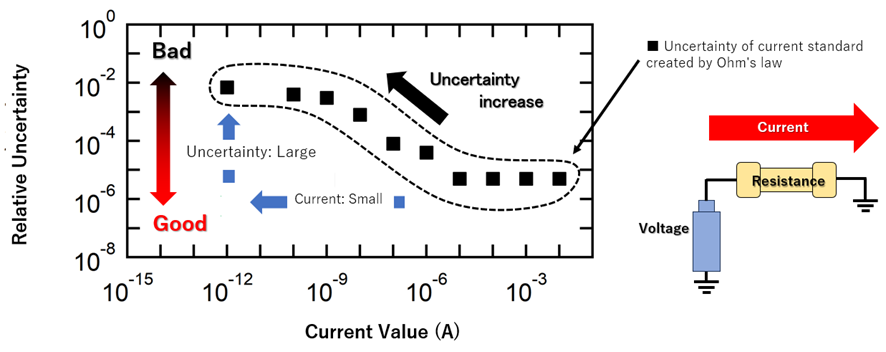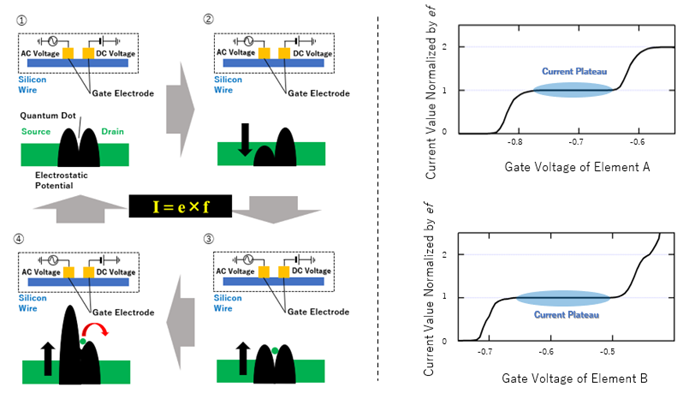NTT Corporation (NTT) and the National Institute of Advanced Industrial Science and Technology (AIST) have achieved a step forward in developing standards for quantum currents by successfully creating a stable and reliable electric current using quantum dots.

Image Credit: NTT Corporation
This study has implications for improving precise measurement technologies by ensuring that the basic rules governing the microscopic world are consistent and could be used to power more devices simultaneously, leading to advancements in current comparison and multiplication techniques. The research involved collaboration between Shuji Nakamura, Senior Research Engineer (AIST), Nobuhisa Kaneko, Principal Researcher (AIST), Akira Fujiwara, Senior Distinguished Researcher (NTT) and Gento Yamahata, Distinguished Researcher (NTT).
This research was published in Nano Letters, a monthly peer-reviewed scientific journal published by the American Chemical Society, and can be accessed here: Universality and Multiplication of Gigahertz-Operated Silicon Pumps with Parts Per Million-Level Uncertainty.
Extremely precise measurement technology is increasingly important in fields like microfabrication, physics, and chemistry. To measure these currents, a "current standard" is used. This standard is achieved by connecting resistors and voltage sources in a way that leverages quantum mechanical phenomena, as seen in the Quantum Hall Resistance Standard and the Josephson Voltage Standard.
These standards are linked through Ohm's law. However, the challenge is as the current becomes smaller, the measurement's relative uncertainty increases (Figure 1, left graph). This is a problem for precise measurements, especially for nanoamperes or less. The work of NTT and AIST works to combat this challenge. This research and development received support from the Japan Society for the Promotion of Science (JSPS) and the Development of Quantum Standard and Extreme Measurement Technology Using Single-Electron Control.

Figure 1. Relationship Between Calibration Uncertainty and Current Value due to Current Produced by Ohm's law. Image Credit: NTT Corporation
NTT and AIST focused on single-electron devices and precision current measurement technology to make accurate measurements for small currents. Meanwhile, NTT is working on current standards using silicon quantum dots, developing technology for the most accurate current generation. In this study, they combined NTT's silicon quantum dot device with AIST's precision current measurement tech. They compared currents generated by two independent silicon quantum dots and confirmed, for the first time globally, that the two matched with an uncertainty of about 4×10-7. By adding the two currents together, they successfully doubled the current while maintaining a small uncertainty. This precise current generation technology and current comparison technology will serve as the “standard” for the measurement of minute currents below nano-ampere, and contribute to the improvement of current measurement accuracy in semiconductor microfabrication, chemical measurement and radiation measurement.
To conduct this research, scientists from NTT and AIST created two tiny silicon quantum dots (Element A and Element B), each a few tens of nanometers in size, using advanced microfabrication technology. The devices were made at NTT, and precise current measurements were taken at AIST. To generate a current, a negative voltage is initially applied to two gate electrodes, creating quantum dots in a silicon wire (Figure 2). Then, by applying a positive voltage to one of the gate electrodes, the energy barrier in the silicon wire is lowered, guiding electrons into the quantum dot. By adjusting voltages, a series of operations continuously transfers electrons one by one, generating a current. The actual results, shown in the experiment, reveal a region (current plateau) where the current remains constant despite changes in voltage.

Figure 2. Mechanism of Current Generation by Silicon Quantum Dots (Left) and Current Generated by Two Elements (Right). Image Credit: NTT Corporation
The collaborative efforts of NTT Corporation (NTT) and the National Institute of Advanced Industrial Science and Technology (AIST) represent a significant advancement in the development of quantum current standards. By successfully harnessing silicon quantum dots to create a stable and reliable electric current. The researchers addressed challenges in precise measurement technologies, particularly for extremely small currents. The achievement not only ensures consistency in the fundamental rules governing the microscopic world but also holds the potential to power multiple devices simultaneously, paving the way for advancements in current comparison and multiplication techniques.
Source: https://group.ntt/en/